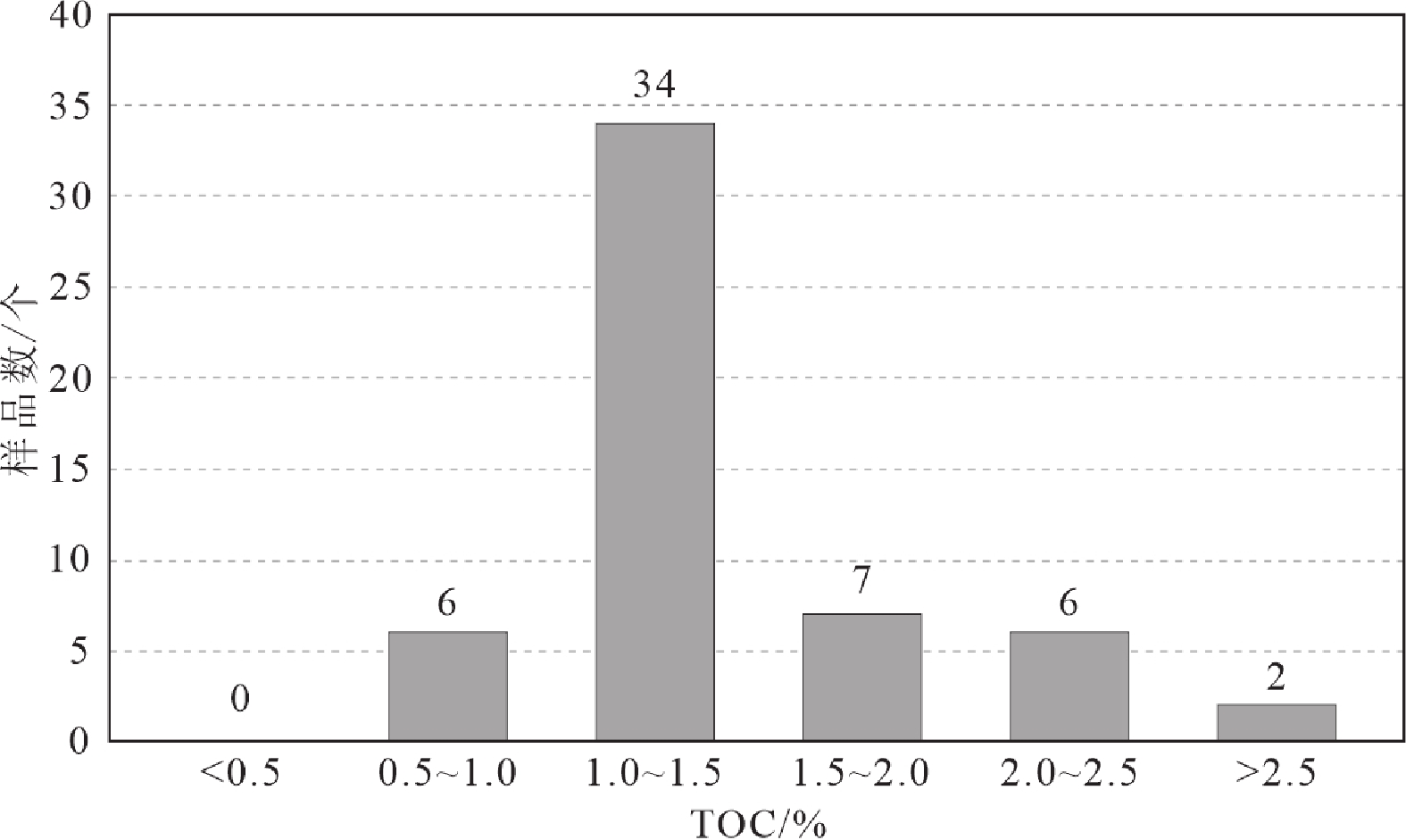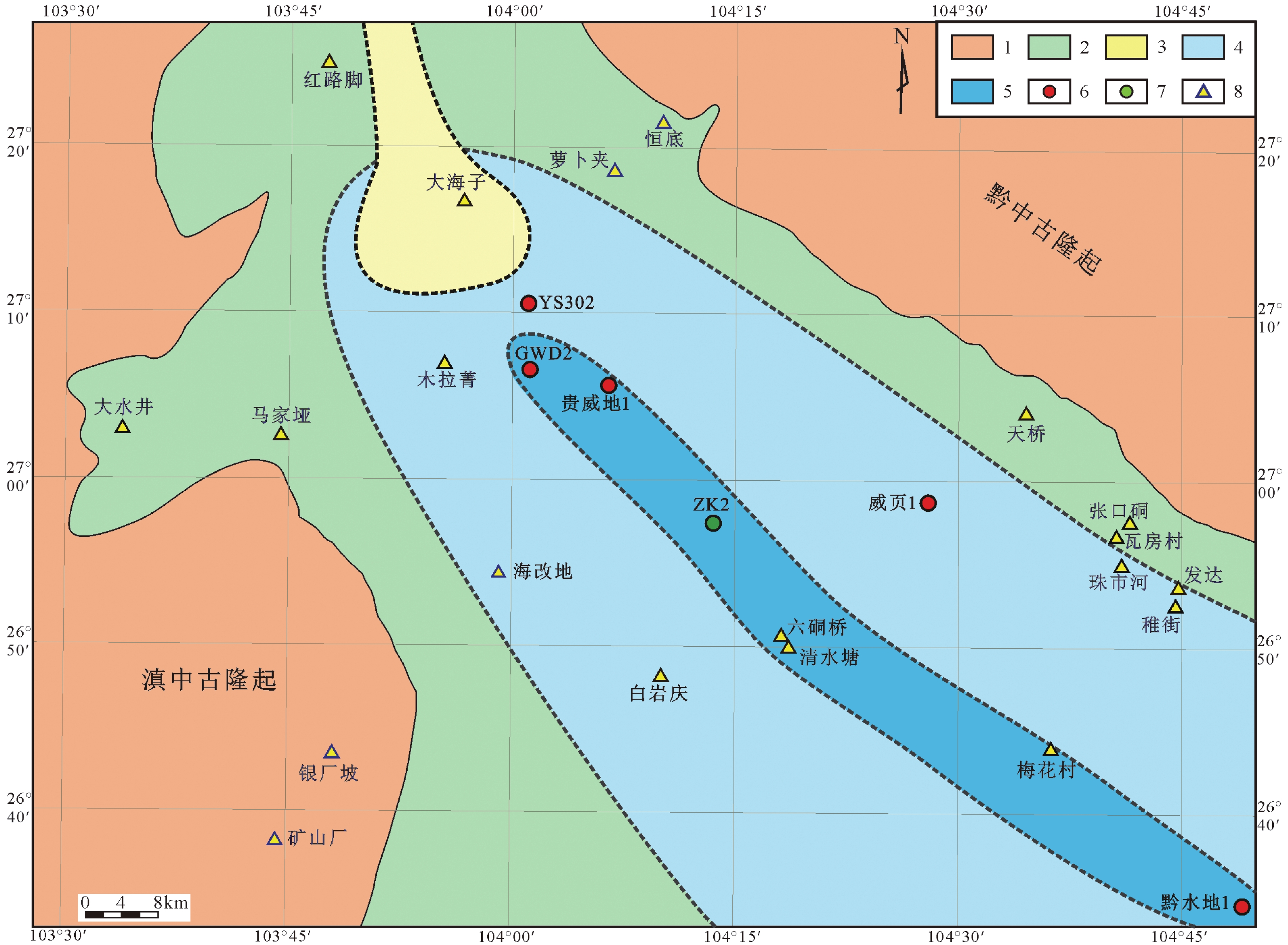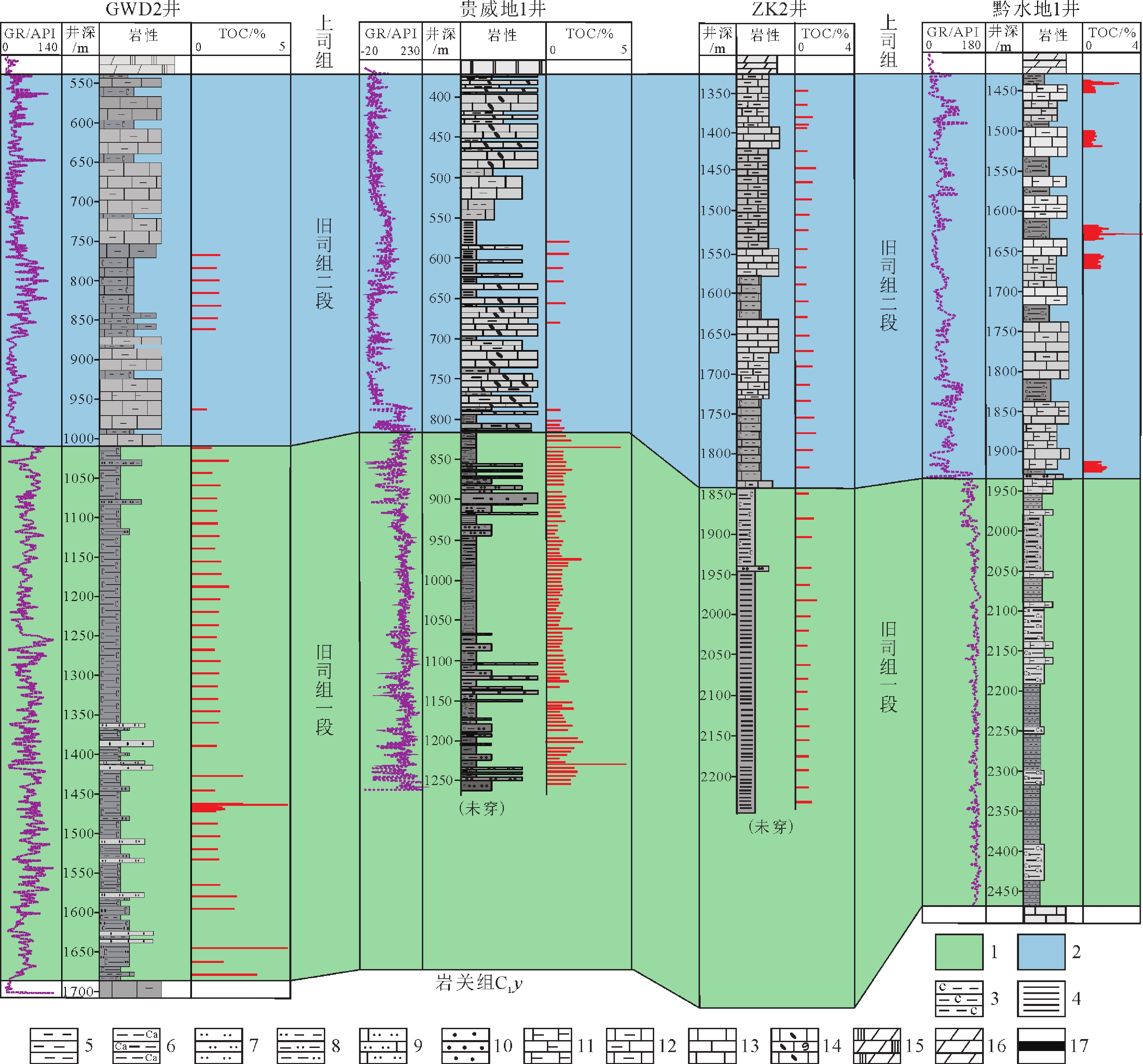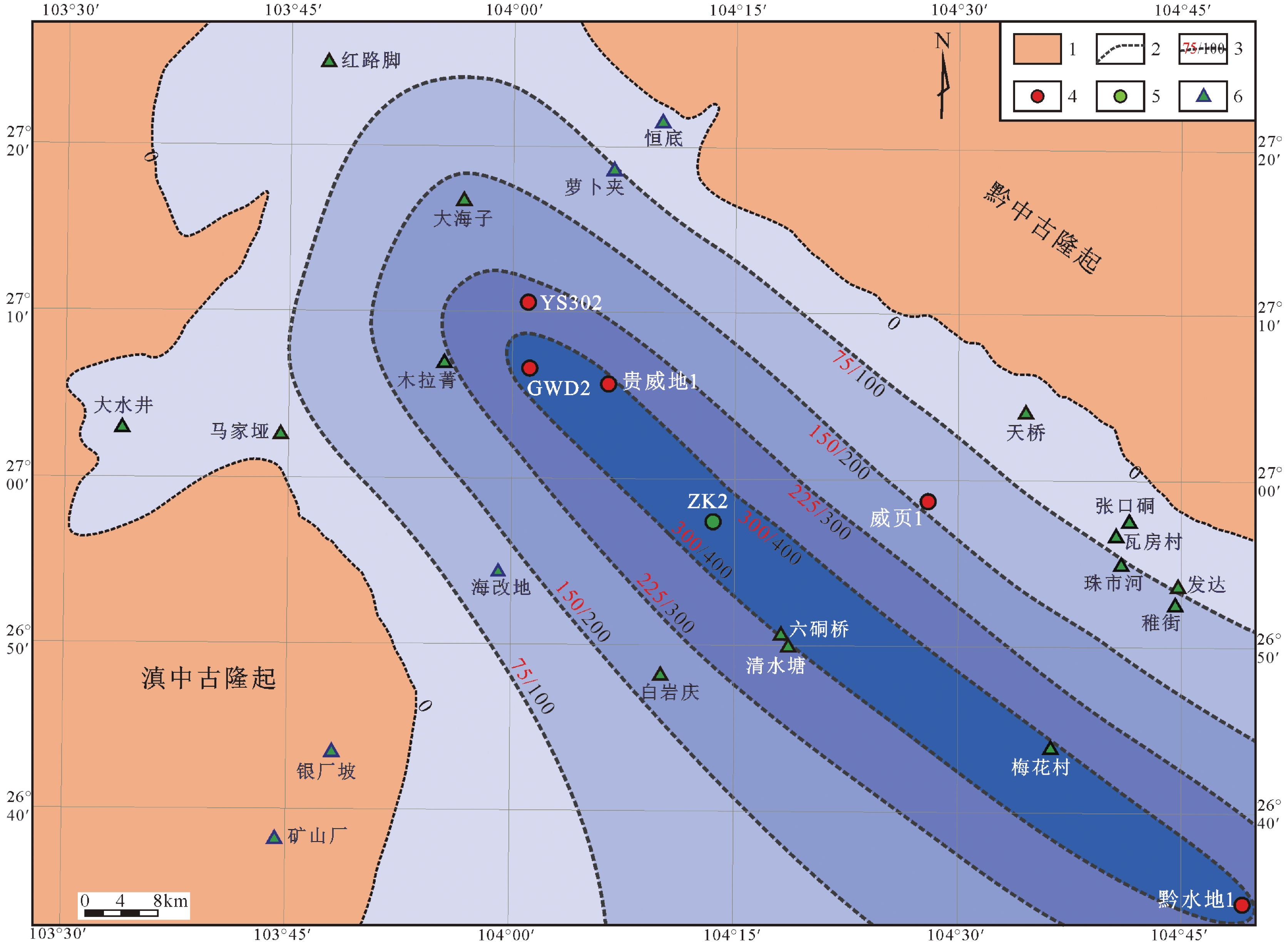Development characteristics of Lower Carboniferous Jiusi Formation dark shale in well GWD–2 and its constraint to hydrocarbon generation center in the northwest of Yadu–Ziyun–Luodian aulacogen, the upper Yangtze Platform
-
摘要:
研究目的 上扬子垭紫罗裂陷槽内广泛分布下石炭统旧司组暗色泥页岩,其厚度变化大,该裂陷槽北西段旧司组暗色泥页岩发育特征和生烃中心展布并不清楚。
研究方法 通过对GWD2井旧司组的测录井以及岩心观察、岩石薄片鉴定、干酪根类型显微鉴定、有机碳含量、镜质体反射率测定等资料的综合分析,对旧司组的地层–沉积相、暗色泥页岩分布和有机地化特征进行了详细研究。
研究结果 (1)该井下石炭统旧司组地层厚度大,钻厚1148.67 m,按照岩石组合特征可细分为两段以及五亚段;(2)泥页岩主要分布在旧一段,以三角洲–浅水陆棚相沉积为主,泥页岩累积厚度525 m,TOC≥1%泥页岩累积厚度大,可达425 m;(3)该井旧司组暗色泥页岩TOC值集中在1%~2%区间内,有机质类型为Ⅱ2型和Ⅲ型干酪根,有机质处于过成熟早期阶段;(4)旧司组沉降中心呈NW–SE向长条状展布,生烃中心与沉降中心分布一致,TOC≥1%的泥质岩烃源岩厚度可达300 m以上,生烃中心具有泥质烃源岩厚度巨大、有机质类型较好、热演化程度较高的生烃条件。
结论 垭紫罗裂陷槽北西段生烃中心下石炭统旧司组泥页岩的生烃强度和总生烃量相当可观,且具有较好的天然气勘探潜力。
Abstract:This paper is the result of oil and gas exploration engineering.
Objective Dark shales in Lower Carboniferous upper are widely distributed in the Yadu–Ziyun–Luodian aulacogen, the upper Yangtze Platform, and its thickness varies greatly. In particular, the development characteristics and hydrocarbon generation center distribution of the dark shale of Jiusi Formation in the northwest section of the rift aulacogen are not clear.
Methods The strata, sedimentary facies, dark shale distribution and organic geochemical characteristics of Jiusi dark shale in well GWD–2 are studied in detail by the logging, core observation, rock thin−section identification, kerogen type microscopic identification, TOC, vitrinite reflectance measurement and other experimental test data. And the following research results were obtained.
Results (1) The drilling thickness of Jiusi Formation in the well GWD–2 is 1148.67 m, according to the characteristics of rock combinations, the Lower Carboniferous Jiusi Formation can be divided into two members and five sub−members. (2) The dark shales are mainly distributed in the first member of Jiusi Formation, which are mainly composed of tidal flat by delta and shallow shelf facies deposits, the cumulative thickness of shale is 525 m, the cumulative thickness of shale with TOC value greater than 1% is 425 m. (3) The TOC value of Jiusi shale of the well is concentrated in the range of 1%−2%, the type of organic matter is mainly type II2 kerogen and III kerogen, the organic matters are in the early stage of over maturity. (4) It is predicted that the subsidence center of Jiusi Formation is distributed in a long strip with NW–SE direction, and the distribution of hydrocarbon generation center is consistent with the subsidence center. The thickness of argillaceous source rock with TOC value greater than 1% can reach more than 300 m. The hydrocarbon generation center has the hydrocarbon generation conditions of argillaceous source rock with huge thickness, good organic matter type and high degree of thermal evolution.
Conclusions It is concluded that the shale of Lower Carboniferous Jiusi Formation in the hydrocarbon generation center of the northwest section of Yadu–Ziyun–Luodian aulacogen has considerable hydrocarbon generation intensity and total hydrocarbon generation, and has good natural gas exploration potential.
-

-
图 1 上扬子垭紫罗裂陷槽北西段地质简图及贵州威宁六硐桥剖面下石炭统地层柱状图(a据王尚彦等, 2006和韩伟, 2010;b、c据贵州省地质局, 1973
1 修改)Figure 1.
图 6 上扬子垭紫罗裂陷槽北西段下石炭统旧司组沉积相平面展布图(据田硕夫和杨瑞东, 2016; 卢树藩等, 2021; Yuan et al., 2022修改)
Figure 6.
图 7 垭紫罗裂陷槽北西段生烃中心旧司组泥页岩横向对比图(井位见图1,黔水地1井资料据陈相霖等, 2021,黔水地1井地层划分方案为笔者修改)
Figure 7.
表 1 GWD2井下石炭统旧司组暗色页岩和煤岩岩心TOC、Ro和岩石热解参数统计
Table 1. Statistics of TOC, Ro and rock pyrolysis of Lower Carboniferous Jiusi Formation dark shale and coal in the well GWD–2
深度/m 岩性 TOC/
%Ro/
%S1/
(mg/g)S2/
(mg/g)Tmax/
℃(S1+S2)/
TOC1388.40 页岩 1.29 2.31 0.05 0.11 559 12.5 1462.10 页岩 2.66 2.46 0.01 0.23 558 9.0 1463.30 页岩 4.53 2.42 0.02 0.39 554 9.0 1463.39 煤岩 18.02 2.48 0.06 1.58 553 9.1 1465.30 页岩 1.33 2.44 0.01 0.12 552 9.8 1466.45 页岩 1.58 2.47 0.02 0.13 554 9.5 1467.20 页岩 0.97 2.34 0.01 0.09 554 10.3 1468.00 页岩 1.60 2.38 0.01 0.13 554 8.8 1468.75 页岩 1.74 2.49 0.02 0.15 554 9.8 1469.30 页岩 1.52 2.54 0.02 0.13 554 9.9 表 2 垭紫罗裂陷槽北西段下石炭统旧司组地层厚度和暗色泥页岩厚度统计
Table 2. Statistics of stratum thickness, shale thickness and argillaceous source rock of the Lower Carboniferous Jiusi Formation in the NW section of Yadu–Ziyun–Luodian aulacogen
钻井/剖面名称 地层厚度/m 泥页岩厚度/m 泥质烃源岩厚度/m
(TOC≥1%)备注及数据来源 贵威1井 >885 >487 >205 未见底,笔者实测 黔水地1井 1003 418 279 陈相霖等, 2021 威页1井 323 180 122 秦琴等, 2016 ZK2井 >900 >450 >190 未见底,笔者修测 YS302井 377 梅珏等, 2021 六硐桥—清水塘 992 470 >200 实测 红路脚 111 45 30 笔者修测 马家垭 197 70 39 笔者实测 木拉箐 670 260 190 笔者实测 梅花村 >301 >85 >10 未见底,笔者实测 大海子 558 185 143 笔者实测 珠市河 >180 >80 >25 未见底,笔者修测 恒底 104 45 24 笔者实测 大水井 17 9 5 笔者实测 发达—稚街 450 200 115 笔者修测 张口硐—瓦房村 81 30 17 笔者修测 海改地 325 130 威宁幅区调报告 1 白岩庆 673 404 威宁幅区调报告 1 萝卜夹 236 110 威宁幅区调报告 1 表 3 上古生界泥质烃源岩生烃潜力评价等级划分标准(据梁狄刚等, 2008;陈建平等, 2012)
Table 3. Evaluation criteria of the generation potential in the Upper Paleozoic argillaceous source rock (after Liang Digang et al., 2008; Chen Jianping et al., 2012)
评价岩类 有机碳含量(TOC/%)分级 非 差 中等 好 很好 极好 Ⅱ型泥质烃源岩 <0.5 0.5~1.0 1.0~2.0 2.0~3.0 3.0~5.0 >5.0 Ⅲ型泥质烃源岩 <0.5 0.5~1.0 1.0~2.5 2.5~4.0 4.0~7.0 >7.0 -
[1] Chen Jianping, Liang Digang, Zhang Shuichang, Deng Chunping, Zhao Zhe, Zhang Dijia. 2012. Evaluation criterion and methods of the hydrocarbon generation potential for China’s Paleozoic marine source rocks[J]. Acta Geologica Sinica, 86(7): 1132−1142 (in Chinese with English abstract).
[2] Chen Xianglin, Yuan Kun, Lin Tuo, Jin Chunshuang, Kang Haixia. 2021. Discovery of shale gas within Upper Paleozoic marine facies by Qian Shuidi–1 Well in the northwest of Yaziluo rift trough, Sichuan Province[J]. Geology in China, 48(2): 661−662 (in Chinese).
[3] Dong Guodong, Zhao Weibo, Zhang Ziyang, Lu Zixing, Fu Xunxun, Peiwenchao, Gao Xing. 2023. Origin and distribution of sandstone in the Taiyuan Formation in Yulin–Qingjian area of Ordos basin[J]. Journal of East China University of Technology (Natural Science), 46(4): 368−375 (in Chinese with English abstract).
[4] Feng Weiming, Li Rong, Zhao Zhan, Yu Qian, Xie Yuan. 2019. The discovery of tight gas and shale gas in Carboniferous strata in Guiweidi 1 Well, Weining County, Guizhou Province[J]. Geology in China, 46(5): 1241−1242 (in Chinese).
[5] Feng W M, Li R, Zhao Z, Yu Q, Liu W, Cao J F. 2023. Geological characterization and exploration potential of shale gas in the Carboniferous Jiusi Formation, northern Guizhou and Yunnan provinces, SW China[J]. Energy Geoscience, 4(3): 1−13.
[6] Ge Jiawang. Zhu Xiaonin. Lei Yongchang, Yu Fusheng. 2021. Tectono−sedimentary development of multiphase rift basins: An example of the Lufeng Depression[J]. Earth Science Frontiers, 28(1): 77−89 (in Chinese with English abstract).
[7] Han Wei. 2010. The Tectonic Evolution and Geological Potentiality in Ziyun–Luodian–Nandan Belt[D]. Xi’an: Northwest University, 8–67 (in Chinese with English abstract).
[8] Hu Dongfeng, Wei Zhihong, Liu Ruobing, Fan Zhiwei, Han Jing. 2018. Development characteristics and shale gas exploration potential of the Lower Carboniferous black shale in the Guizhong Depression[J]. Natural Gas Industry, 38(10): 28−37 (in Chinese with English abstract).
[9] He Jianglin, Liu Wei, Yu Qian, Qiu Zhen, He Yongzhong, Guo Tianxu, Wang Zhengjiang, Yang Ping. 2017. Geological characteristics of Lower Carboniferous Jiusi shale and its favorable area for shale gas exploration in Guizhou Province[J]. Chinese Journal of Geology, 52(1): 203−217 (in Chinese with English abstract).
[10] Qin Qin, Long Chengxiong, Tang Xiangui. 2016. Analysis of Carboniferous Jiusi Formation shale sedimentary environment in southwestern Guizhou[J]. Coal Geology of China, 28(4): 35−40 (in Chinese with English abstract).
[11] Qin Yinglun, Zhang Jiazheng, Wang Yufang, Kang Haixia, Li Juan, Zhang Ziya, Xue Zong'an, Zhang Yunxiao. 2021. Discovery of shale gas by Guirongye–1 Well within Carboniferous Luzhai Formation in Guizhong depression, Guangxi[J]. Geology in China, 48(2): 667−668 (in Chinese).
[12] Li Kai. 2016. Shale gas accumulation condition of Lower Carboniferous Jiusi Formation in Weining–Shuicheng[J]. Special Oil & Gas Reservoirs, 23(5): 48−53 (in Chinese with English abstract).
[13] Li Rufeng, Liu Benpei, Zhao Chenglin. 1997. Correlation of Carboniferous depositional sequences on the Yangtze Plate with others on a global scale[J]. Acta Sedimentologica Sinica, 15(3): 23−28 (in Chinese with English abstract).
[14] Liang Digang, Guo Tonglou, Chen Jianping. Bian Lizeng, Zhao Zhe. 2008. Some progresses oil studies of hydrocarbon generation and accumulation in marine sedimentary regions, Southern China (Part 1): Distribution of four suits of regional marine source rocks[J]. Marine Origin Petroleum Geology, 13(2): 1−16 (in Chinese with English abstract).
[15] Lin Yuxiang, Zhao Chengjin, Zhu Chuanzhen, Wu Yuchen, Li Jia, Li Xiuqin. 2016. Migration pattern and geodynamic mechanism of Cenozoic depocenter and subsidence center in Huimin Sag, Bohai Bay Basin[J]. Oil & Gas Geology, 37(4): 509−519 (in Chinese with English abstract).
[16] Liu Chiyang. 2008. Dynamics of sedimentary basin and basin reservoir (ore) forming system[J]. Journal of Earth Sciences and Environment, 30(1): 1−23 (in Chinese with English abstract).
[17] Lu Shufan, Chen Yi, Luo Xiangjian, He Ben, Fu Hongbin. 2021. Sedimentary characteristics and distribution of the Carboniferous black shale in Guizhou Province[J]. Acta Sedimentologica Sinica, 39(3): 672−685 (in Chinese with English abstract).
[18] Lu Shufan, He Ben, Du Shengjiang. 2016. Geological conditions and exploration prospect of shale gas in Dawuba Formation of Lower Carboniferous of Daiye–1 Well in southern Guizhou Province[J]. Geological Survey of China, 3(4): 6−11 (in Chinese with English abstract).
[19] Mei Jue, Ji Yubing, Ren Jinglun, Zhang Hanbing, Zhou Yun. 2021. Shale gas accumulation conditions in the Lower Carboniferous Jiusi Formation of Dianqianbei Depression[J]. Natural Gas Industry, 41(S1): 51−59 (in Chinese with English abstract).
[20] Mei Mingxiang, Ma Yongsheng, Deng Jun, Chu Hanmin, Liu Zhirong, Zhang Hai. 2005. Carboniferous to Permian sequence stratigraphic framework of the Yunnan–Guizhou–Guangxi basin and its adjacent areas and global correlation of third–order sea–level change[J]. Geology in China, 32(1): 13−24 (in Chinese with English abstract).
[21] Patrick M, Juerg H, Stuart C. 2022. Tilting of the Australian continent: New evidence from the subsidence and deposition history of the Northern Carnarvon Basin[J]. Marine and Petroleum Geology, 137: 1−21.
[22] Tian Shuofu, Yang Ruidong. 2016. Lithofacies and paleogeography evolution and characteristics of shale accumulation in Lower Carboniferous, Guizhou, China[J]. Journal of Chengdu University of Technology (Science & Technology Edition), 43(3): 291−299 (in Chinese with English abstract).
[23] Tian Wei, Peng Zhongqin, Bai Yunshan, Wang Baozhong, Wang Qiang, Miao Fengbin, Liu Feiyu. 2019. Reservoir characteristics and exploration potential of Lower Carboniferous shale gas in Lianyuan Sag, Central Hunan[J]. Earth Science, 44(3): 939−952 (in Chinese with English abstract).
[24] Wang Shangyan, Zhang Hui, Wang Tianhua, Wang Chunhou, Peng Chenglong, Hu Renfa, Chen Minghua, Shi Lei. 2006. Filling and evolution of the Late Paleozoic Shuicheng–Ziyun aulacogen in western Guizhou, China[J]. Geological Bulletin of China, 25(3): 402−407 (in Chinese with English abstract).
[25] Yuan K, Huang W H, Wang T, Li S Z, Sun X C, Fang X X, Xiao J P, Guo J. 2022. Tectonic evolution and accumulation characteristics of Carboniferous shale gas in Yadu–Ziyun–Luodian aulacogen, South China[J]. China Geology, 6(4): 646−659.
[26] Yuan Kun, Wang Chao, Qin Yinglun, Yu Shufang, Chen Rong, Shi Dishi, Bao Shujing, Lin Tuo, Zhou Zhi. 2017. The discovery of Carboniferous shale gas in Qianziye–1 Well of Qianan (southern Guizhou) depression[J]. Geology in China, 44(6): 1253−1254 (in Chinese).
[27] Yuan Kun, Wang Keying, Gong Shuhua, Qin Yinglun, Lu Shufan, Chen Rong, Fang Xinxin. 2018. Shale gas enrichment features and impacting factors in Carboniferous Dawuba Formation, Southern Guizhou Area[J]. Coal Geology of China, 30(3): 28−34 (in Chinese with English abstract).
[28] Yang Ping, Chen Yang, Feng Weiming, Mou Bixin, Wei Honggang, Ke Kun, Liu Jiahong, He Lei. 2021. Key indexes for hydrocarbon formation of tight sandstones and favorable areas of Baiguowan Formation in Xichang Basin[J]. Sedimentary Geology and Tethyan Geology, 41(3): 454−464 (in Chinese with English abstract).
[29] Zhang Haiquan, Wang Zhenghe, Wang He, Liu Wei. 2016. REE geochemistry and sedimentary–tectonic setting of the Early Carboniferous black rock series in southern Guizhou[J]. Sedimentary Geology and Tethyan Geology, 36(3): 30−36 (in Chinese with English abstract).
[30] Zhu Guangyou, Jin Qiang, Zhang Shuichang, Guo Changchun, Zhang Shanwen. 2005. Research on the genetic type and hydrocarbon generation potential of the hydrocarbon generation sag in Jiyang depression[J]. Natural Gas Industry, 25(11): 17−20 (in Chinese with English abstract).
[31] 陈建平, 梁狄刚, 张水昌, 邓春萍, 赵拮, 张蒂嘉. 2012. 中国古生界海相烃源岩生烃潜力评价标准与方法[J]. 地质学报, 86(7): 1132−1142. doi: 10.3969/j.issn.0001-5717.2012.07.009
[32] 陈相霖, 苑坤, 林拓, 金春爽, 康海霞. 2021. 贵州垭紫罗裂陷槽西北缘(黔水地1井)发现上古生界海相页岩气[J]. 中国地质, 48(2): 661−662. doi: 10.12029/gc20210222
[33] 董国栋, 赵伟波, 张紫阳, 卢子兴, 付勋勋, 裴文超, 高星. 2023. 鄂尔多斯盆地榆林—清涧地区太原组砂岩成因与分布[J]. 东华理工大学学报(自然科学版), 46(4): 368−375.
[34] 冯伟明, 李嵘, 赵瞻, 余谦, 谢渊. 2019. 贵州威宁地区贵威地1井钻获石炭系页岩气和致密砂岩气[J]. 中国地质, 46(5): 1241−1242. doi: 10.12029/gc20190525
[35] 葛家旺, 朱筱敏, 雷永昌, 于福生. 2021. 多幕裂陷盆地构造–沉积响应及陆丰凹陷实例分析[J]. 地学前缘, 28(1): 77−89.
[36] 韩伟. 2010. 紫云–罗甸–南丹裂陷带的构造演化及地质意义[D]. 西安: 西北大学, 8–67.
[37] 胡东风, 魏志红, 刘若冰, 范志伟, 韩京. 2018. 桂中坳陷下石炭统黑色页岩发育特征及页岩气勘探潜力[J]. 天然气工业, 38(10): 28−37. doi: 10.3787/j.issn.1000-0976.2018.10.004
[38] 何江林, 刘伟, 余谦, 邱振, 贺永忠, 郭天旭, 汪正江, 杨平. 2017. 贵州下石炭统旧司组页岩气地质特征及有利区优选[J]. 地质科学, 52(1): 203−217. doi: 10.12017/dzkx.2017.013
[39] 秦琴, 龙成雄, 唐显贵. 2016. 黔西南地区石炭系旧司组页岩沉积环境分析[J]. 中国煤炭地质, 28(4): 35−40. doi: 10.3969/j.issn.1674-1803.2016.04.07
[40] 覃英伦, 张家政, 王玉芳, 康海霞, 李娟, 张子亚, 薛宗安, 张云枭. 2021. 广西桂中坳陷(桂融页1井)石炭系鹿寨组获页岩气重要发现[J]. 中国地质, 48(2): 667−668. doi: 10.12029/gc20210225
[41] 李凯. 2016. 威宁—水城下石炭统旧司组页岩气成藏条件[J]. 特种油气藏, 23(5): 48−53. doi: 10.3969/j.issn.1006-6535.2016.05.011
[42] 李儒峰, 刘本培, 赵澄林. 1997. 扬子板块石炭纪沉积层序及其全球性对比研究[J]. 沉积学报, 15(3): 23−28.
[43] 梁狄刚, 郭彤楼, 陈建平, 边立曾, 赵喆. 2008. 中国南方海相生烃成藏研究的若干新进展(一): 南方四套区域性海相烃源岩的分布[J]. 海相油气地质, 13(2): 1−16. doi: 10.3969/j.issn.1672-9854.2008.02.001
[44] 林玉祥, 赵承锦, 朱传真, 吴玉琛, 李佳, 李秀芹. 2016. 济阳坳陷惠民凹陷新生代沉积−沉降中心迁移规律及其机制[J]. 石油与天然气地质, 37(4): 509−519. doi: 10.11743/ogg20160407
[45] 刘池洋. 2008. 沉积盆地动力学与盆地成藏(矿)系统[J]. 地球科学与环境学报, 30(1): 1−23. doi: 10.3969/j.issn.1672-6561.2008.01.001
[46] 卢树藩, 陈祎, 罗香建, 何犇, 符宏斌. 2021. 贵州石炭系黑色页岩层系沉积特征及分布规律研究[J]. 沉积学报, 39(3): 672−685.
[47] 卢树藩, 何犇, 杜胜江. 2016. 黔南代页1井下石炭统打屋坝组页岩气地质条件及勘探前景[J]. 中国地质调查, 3(4): 6−11.
[48] 梅珏, 计玉冰, 任景伦, 张涵冰, 周芸. 2021. 滇黔北坳陷下石炭统旧司组页岩气成藏条件[J]. 天然气工业, 41(S1): 51−59.
[49] 梅冥相, 马永生, 邓军, 初汉民, 刘智荣, 张海. 2005. 滇黔桂盆地及其邻区石炭纪至二叠纪层序地层格架及三级海平面变化的全球对比[J]. 中国地质, 32(1): 13−24. doi: 10.3969/j.issn.1000-3657.2005.01.002
[50] 田硕夫, 杨瑞东. 2016. 贵州早石炭世岩相古地理演化及页岩气成藏特征[J]. 成都理工大学学报(自然科学版), 43(3): 291−299.
[51] 田巍, 彭中勤, 白云山, 王保忠, 王强, 苗凤彬, 刘飞宇. 2019. 湘中涟源凹陷石炭系测水组页岩气成藏特征及勘探潜力[J]. 地球科学, 44(3): 939−952.
[52] 王尚彦, 张慧, 王天华, 王纯厚, 彭成龙, 胡仁发, 陈明华, 石磊. 2006. 黔西水城—紫云地区晚古生代裂陷槽盆充填和演化[J]. 地质通报, 25(3): 402−407. doi: 10.3969/j.issn.1671-2552.2006.03.010
[53] 苑坤, 王超, 覃英伦, 于抒放, 陈榕, 石砥石, 包书景, 林拓, 周志. 2017. 黔南地区(黔紫页1井)发现上古生界海相页岩气[J]. 中国地质, 44(6): 1253−1254.
[54] 苑坤, 王克营, 巩书华, 覃英伦, 卢树藩, 陈榕, 方欣欣. 2018. 黔南地区石炭系打屋坝组页岩气富集特征及其影响因素[J]. 中国煤炭地质, 30(3): 28−34. doi: 10.3969/j.issn.1674-1803.2018.03.05
[55] 杨平, 陈杨, 冯伟明, 牟必鑫, 魏洪刚, 客昆, 刘家洪, 何磊. 2021. 西昌盆地白果湾组致密砂岩油气形成关键指标评价与有利区优选[J]. 沉积与特提斯地质, 41(3): 454−464.
[56] 张海全, 王正和, 王鹤, 刘伟. 2016. 黔南地区早石炭世黑色岩系稀土元素地球化学特征及沉积–构造环境分析[J]. 沉积与特提斯地质, 36(3): 30−36. doi: 10.3969/j.issn.1009-3850.2016.03.005
[57] 朱光有, 金强, 张水昌, 郭长春, 张善文. 2005. 济阳坳陷生烃洼陷的成因类型及生烃潜力比较[J]. 天然气工业, 25(11): 17−20. doi: 10.3321/j.issn:1000-0976.2005.11.006
-




 下载:
下载:






